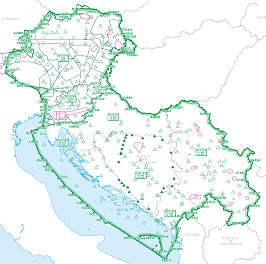In just less than a year after signing the memorandum of cooperation aimed towards merging the two Free Route Airspaces SAXFRA (Slovenian Austrian Cross-border Free Route Airspace) and SEAFRA (South-East Axis Free Route Airspace - project of three ANSPs from Bosnia and Herzegovina, Croatia, Serbia and Montenegro) the South East Common Sky Initiative Free Route Airspace (SECSI FRA) has successfully been implemented, with the support of the Network Manager.
On February 1, the SECSI FRA went operational offering airspace users significant benefits along the South East Axis, by delivering the shortest route options from Central Europe to South Eastern Europe. The benefits gained through the SECSI FRA are substantial. Based on the shortest route assignment potential savings per day are up to 1.940 NM in flight distance, 285 minutes in flight time, a reduction in fuel consumption of 8,000 kg and a reduction in CO2 emissions of 25,500kg.
SECSI FRA is expected to deliver potential savings of 600.000-700.000 NM in flight distance per year. It will make more options available when determining the user-preferred trajectory. Full cross-border FRA allows airlines to take better advantage of wind or adapt to network disruptions. The better use of FRA options at flight planning level improve predictability and reduce ATC workload. This initiative not only works towards achieving the goals of the European Commission regarding the implementation of “Free Route” across Europe but also fulfils airspace user´s requests for having multiple route options available for the same city-pair.
“This is the next significant milestone towards Free Route airspace across all of Europe – step by step Single European Sky is becoming a reality. The South East Common Sky Initiative Free Route Airspace will benefit airlines, passengers and the environment in reducing fuel consumption, travel time and CO2 emissions. ”, said Austro Control CEO Heinz Sommerbauer.
“It is a major achievement, that five ANSPs closely working together were able to implement SECSI FRA in less than a year. This project will not only make the flow of air traffic through Europe more efficient, but is also a clear sign that significant progress towards achieving the goal of a Single European Sky is being made”, said Austro Control COO Thomas Hoffmann.
“BHANSA is pleased to be part of the SECSI FRA project, which, as one of the most complex aviation projects in Europe, required cross border cooperation between five air navigation service providers. Implementation of SECSI FRA concept will result in increase of the flexible use of airspace, environmental protection, reducing of fuel consumption and airspace user costs. Therefore, with this project realization, we are very close to achieving the goal for the most efficient use of the airspace based on actual needs and, where possible, to avoid permanent airspace segregation while optimizing the network performance in line with international aviation standards and recommended practices”, said BHANSA Director Davorin Primorac.
„The implementation of the South East Common Sky Initiative (SECSI) is a significant achievement in the field of airspace organisation. It is a result of innovative technology and excellent relations built between the ANSPs and the Network Manager, while working on many key projects over the years. This initiative offers significant opportunities for further airspace optimisation. The airspace users will benefit from a shorter flight time, reduced fuel consumption and decreased emissions of CO2 and NOx. The expansion of FRA across several borders moves us all towards achieving the Single European Sky“, said Vlado Bagarić, Director General of Croatia Control.
“SECSI FRA is making the future, today. Its implementation is a demonstration that wide European visions are possible, with ANSPs, States, partners, working together for greater benefits of air traffic and fragile environment, but at the same time retaining identity and sovereignty. Building on experience, expertise and with perfect cooperation between five ANSPs and the EUROCONTROL Network Manager, the future multistate cross-border Free Route Airspace is achievable, and working together we can make it a reality on time”, said Slovenia Control CEO Franc Željko Županič.
For Eurocontrol the successful implementation of SECSI FRA also represents an important step towards achieving Free Route airspace across Europe. “Following the successful implementation of the SAXFRA and SEAFRA initiative, the South East Europe Common Sky Initiative is an excellent example of how cross-border Free Route Airspace implementation progresses in Europe in complex airspace. The detailed and innovative work conducted by the five ANSPs in close coordination with the Network Manager and completed in under a year makes this initiative a tangible example of how the European ATM network can be optimised. It opens significant opportunities for further airspace optimisation in Central and South East Europe with similar neighboring initiatives”, said Joe Sultana, Network Manager Director Eurocontrol.
For FAB CE the success of this project is also an important step towards estblishing Free Route airspace across FAB CE and also to Non-EU airspace. FAB CE just recently initiated a project to monitor all Free Route projects within FAB CE.

